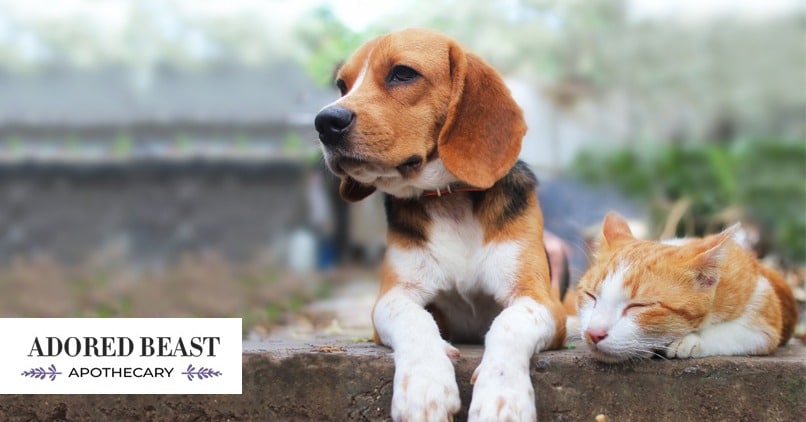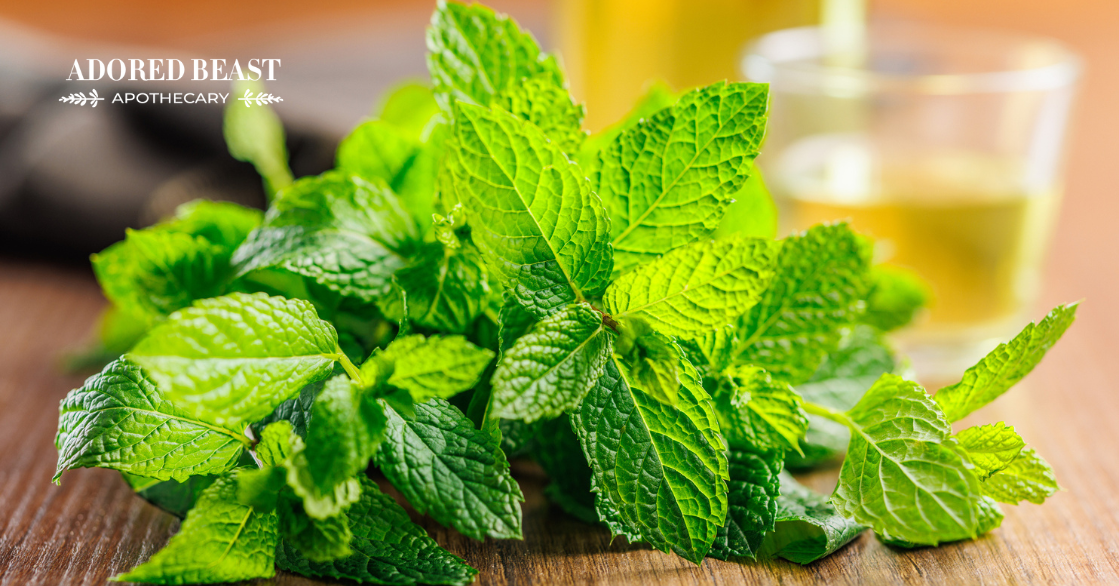Pancreatitis in dogs and cats is a life-threatening condition. Anyone who’s had a pet in this situation knows it can be really scary. Doctors sometimes refer to it as an “idiopathic” condition which means “of unknown cause.” I’d like to challenge that idea and propose that there are some very real causes for it. The best approach is a proactive one to ensure that your pet never has to face this issue. If you have a pet suffering from chronic pancreatitis, keep reading to learn how you can help them recover.
What is Pancreatitis in Dogs and Cats?
The pancreas is a small organ responsible for the production of digestive enzymes and hormones insulin and glucagon. Insulin is secreted to reduce high blood glucose levels. Glucagon is released in order to address low blood glucose. When these functions go awry, it results in high blood sugar (hyperglycaemia/diabetes) or low blood sugar (hypoglycaemia).
This tiny but mighty organ is part of both the endocrine and digestive systems.
Pancreatitis in dogs and cats refers to inflammation of the pancreas. Elevated blood enzymes (amylase and lipase) are signs that your pet could be suffering from pancreatitis. Increased levels of these two enzymes can trigger a dramatic inflammatory response of the pancreatic tissue. This is known as an autoimmune response in which tissue can be damaged and the animal can become gravely ill.
Symptoms of pancreatitis in dogs and cats can include:
- fever
- nausea
- vomiting
- lethargy
- stretching
- severe abdominal pain
- increased blood amylase/lipase
- dehydration
If you see any combination of these symptoms, it’s important to get to the vet right away, especially for those animals with a past history of pancreatitis.
Pancreatitis Doesn’t Just Happen
As mentioned above, many animal care professionals believe that pancreatitis has a mysterious origin but, in my experience, this just isn’t true. There are some concrete reasons that animals develop this disease. Most of the time, it doesn’t develop overnight unless your pet has been poisoned in some way. There is often a medical history that tells the story of how the road was paved for this illness.
The development of pancreatitis in dogs and cats is linked to obesity, diabetes, endocrine disease and irritable bowel disease (IBD). (1) All of these are related to diet. Let’s discuss how these diseases are connected and how we look at it in a holistic light, as one disease instead of many separate ones.
Disease Risk Factors for Pancreatitis in Dogs and Cats
1. Obesity and Hormone Imbalance
Since 2010, pet obesity has increased by 150%. (2) That is a staggering number. 1 in 3 pets is overweight or obese. In humans, the US National Library of Medicine reports that there is a link between visceral body fat distribution and increased risk/severity of pancreatitis. (3)
There is a definite hormonal factor associated with pancreatic disease in our pets. Dogs at highest risk for pancreatitis tend to be neutered or spayed, overweight, and middle-aged. Spayed females carry a particular risk for fatal acute pancreatitis over intact females. (1) As part of the male endocrine system, a function of the testicles is to produce the hormone testosterone which helps regulate fat distribution within the body. Male animals that no longer have their testicular glands are more likely to become obese. Early neuter and spay is particularly problematic for a number of reasons, including increased risk of obesity, diabetes, irritable bowel disease, orthopaedic disease, hypothyroidism, and cancer. (4)
2. Diabetes
Obesity is the number one risk factor for diabetes, a hormone imbalance of insulin secretion. Diabetes occurs in dogs when the insulin-producing cells of the pancreas are damaged or destroyed. This can develop with repeated immune-mediated inflammatory insults to the pancreatic tissue. In cats, the islet cells become compromised but they can often return to normal function with a correction of diet. Yes, that means that feline diabetes is almost always resolved with species-appropriate foods. It’s fair to hypothesize that diabetes may precede pancreatitis in a large number of cases. So, the moral is that we really want to help keep this little organ as happy as possible, especially to avoid diabetes!
3. Liver Disease
Liver disease can occur simultaneously with pancreatitis. It can be acute or chronic and is often related to some type of toxic overload from either diet and/or environmental sources. Stress also plays a role in the development of liver issues. It’s another disease that usually doesn’t just happen overnight unless your pet has been poisoned. Chronic liver issues are often not discovered until your animal is really not feeling well, possibly years after it first develops. This is why wellness check-ups and blood work are so important.
If your pet is suffering from a pancreatic flare-up, bloodwork will show elevated amylase and lipase enzymes in the blood. This can be accompanied by elevated liver enzymes (eg. ALT, ALP, AST, GGT). Pancreatic enzymes can be destructive to the liver when they reach dangerous levels in the bloodstream. Sometimes it’s hard to tell if liver or pancreatic disease is the primary factor. Your vet may suggest further testing to differentiate. But… there is another disease that often precedes both hepatic and pancreatic disease….
4. Irritable Bowel Disease
Irritable bowel disease or IBD is another non-descript term for inflammation of the gastrointestinal (GI) tract. When things are working properly, the GI tract, liver and pancreas all work together in unison to help regulate nutrient intake, toxic load, immune response, hormone balance, some nervous system function, and nutrient synthesis. It does this with the helping hand of the microbiome. The GI tract consists of a layer of specialized cells called the epithelium. The epithelium is made up of 7 different types of cells that specialize in specific aspects of the functions mentioned above. These cells are renewed prolifically in healthy animals (every 4-5 days). One type of epithelial cells (Goblet cells) secrete the protective mucosal layer in which the microbiome lives.
The mucosal layer is the primary defense mechanism for keeping the GI epithelium healthy and disease-free. When this mucosal lining is damaged, the epithelium is exposed to bile acids, potential food and environmental toxins, commencing an inflammatory response which can wreak extreme havoc on the surrounding tissues. Left unchecked, it can affect all systems in the body including digestive, immune, neurological, and endocrine. It has a terrible domino effect. Many alternative practitioners believe that this is where many diseases begin; with a condition known as leaky gut or dysbiosis.
One of the most common causes of digestive damage that I see is from nutritional insult. You can really get ahead of this disease if you address your animal’s diet!
5. Feline Triaditis
Feline triaditis is a multifaceted condition involving inflammation of the pancreas, the bile duct, liver tissue, and the intestinal lining. It can make your cat extremely ill and can be life-threatening. In my experience, animals suffering from triaditis have been sick for a very long time. They are often fragile and need a very gentle approach to help them recover.
It’s All Connected
In holistic terms, dysbiosis, pancreatitis, liver disease, IBD, diabetes, and obesity are not separate diseases. They are all connected. It’s an important consideration because, by supporting the digestive and endocrine systems, you can make a huge difference in the outcome of your animal’s illness.
Early Warning Signs that Your Pet Needs Help
If you want to get ahead of pancreatitis, you must use your keen observation skills to detect early warning signs. They may look like non-descript symptoms but you know your pet best. You will notice small changes in your pet’s health way before a disease is detected by your veterinarian. This is where you can make a huge difference in preventing a major illness. Early warning signs for GI disease that should concern you are:
- Increased drinking and peeing (PU/PD)
- Soft, smelly stools and/or constipation
- Intermittent vomiting and/or diarrhea
- Change in eating behaviours (eg. pickiness or ravenous hunger)
- Intermittent lethargy
- Sudden weight loss or gain
- Skin disease/allergies
- Change in behaviour (eg. fear, aggression, etc.)
If you see any combination of these symptoms, it’s time to book a wellness check up with your holistic veterinarian.
Other Risk Factors for Pancreatitis in Dogs and Cats
- Processed/high starch diets
- High fat diets
- Microbiome imbalance (eg. antibiotics and infections)
- Digestive disease (e.g. IBD)
- Endocrine (hormone) imbalance or disease
- Trauma to the pancreas
- Some seizure medications
- Breed disposition (small breeds in particular)
Nutritional Risk Factors and Solutions
Ok, let’s talk about diet. Nutrition has a huge influence on disease development. This is especially true for digestive diseases like pancreatitis. Diet will have a major influence on the prognosis of your pet. It’s one of the foundations of health and affects how the digestive organs function. Here’s how things can go wrong with diet and also how you can help make them right.
1. Commercial Pet Food
There is an overwhelming selection of commercial raw pet food diets these days. Unfortunately, there’s no regulation in Canada relating to standards, quality and balance in the pet food industry. In the US, the FDA does some regulation but it’s minimal. AAFCO (the American Association of Feed Control Officials) lays out the standards for pet food but it isn’t a regulatory organization. That means: AAFCO only assumes that pet food companies are following the rules but no one is actually checking! This goes for commercial processed feed, raw diets, and everything in between. It means that YOU (the pet parent) have to be educated on what to look for so that you’re not causing stress or illness to your pet. Below are some of the ways processed and poorly balanced raw food diets can pave the way for disease.
2. Microbiome Imbalance
Diet is highly influential on the microbiome. New research shows that dogs that eat a raw diet have healthier microbiomes than processed-fed dogs. (5) The GI mucosal barrier is the home of your pet’s microbiome. Damage to this lining can occur simply from feeding the wrong diet. And it can happen years before you see any symptoms. A healthy gut starts with fresh food! If you suspect your pet has a microbiome imbalance, probiotics are also in order.
3. Too Much Saturated Fat
Have you ever heard someone say that raw diets cause pancreatitis? Fat excess is one of the reasons that this statement holds some merit. (6) One method that some raw pet food companies use to cut costs is to use fat (“trim”) instead of lean meat. Trim is much cheaper than premium cuts of muscle meat. Muscle and fat are both important pieces of the raw diet but sometimes, they are not in balance and high saturated fat content can cause pancreatic stress.
The pancreas is responsible for excreting the enzyme lipase which is necessary for fat digestion. Excessive dietary fat can cause a great deal of stress to this little organ. A lot of pet parents are, unknowingly, feeding too much fat. If your pet has a pancreatic episode while switching to raw, it’s not just the diet causing the issue. Your pet is already in deep inflammatory distress and switching them to a high fat raw diet simply exacerbates the problem.
- Healthy dogs need between 8-12% fat in their daily diet unless they are athletes or severely underweight, in which case, their requirements may change.
- Healthy cats should have 8-10% fat in their daily diet.
Animals with chronic pancreatitis will most likely need reduced fat intake until they recover. And yes, you can still accomplish this with fresh food. It’s best to consult a professional to determine the best dietary route for your pet.
4. Omega 3 and 6 Fatty Acid Imbalance
Most pet food (even most raw pet foods) is deficient in omega 3 fatty acids. This can set your pet up for inflammation in all areas of the body so you need to ensure that you are balancing your fats.
A well-balanced diet must include sufficient omega 3s which are known to have anti-inflammatory effects, especially in the digestive system. The minimum ratio is a 4:1 omega 6:3 fatty acid ratio but you can include more omega 3s if your pet is suffering from inflammatory disease.
It’s imperative that your fatty acids come from whole food sources if your pet has pancreatitis. Poor quality oils can cause GI upset and they can also be rancid, defeating their purpose or even making your pet worse.
Fatty acid-rich foods include:
- Phytoplankton
- Canned Atlantic sardines packed in water (not oil) – ¼ – ½ fish every second day
- Whole fish roe – ½ – 1 tsp per 20 lbs of bodyweight
- Whole ground flax (dogs) – 1 tsp per 20 lbs
- Soaked chia seeds (dogs) – 1 tsp per 20 lbs
- Raw and/or fermented goat milk – ¼ – ½ oz. per 10 lbs
5. Too Much Sugar
Processed starch converts to sugar in the digestive system, increasing blood sugar and insulin secretion. It puts your pet at risk for obesity and overworks the pancreas. Highly processed starches such as grain meals, pea meals, and lentil meals are not appropriate food sources for dogs or cats who have no nutritional need for dietary carbohydrate, especially processed carbs. Believe it or not, legume diets can contain just as much starch as grain diets so it’s best to steer clear of both for pancreatic health. For some very odd reason, carbs are not required to be listed on pet food labels so you will have no idea how much starch you are feeding if you feed processed food. (7)
6. Not Enough Good Fibre
There’s a great debate among pet parents and professionals about vegetables for dogs and cats. Some feel they don’t need vegetables because they are carnivores but dogs can benefit greatly from the right types of veggies in their diet, providing antioxidants and healthy fibre that can aid in the recovery of IBD, diabetes and pancreatitis. Even cats benefit from small amounts of juiced green veggies and/or oat grass. Fermented, freshly blended and juiced vegetables are all great options too. Veggies that I like to include: green leaf vegetables, organic grasses, winter squash, yams, parsnips and beets. Fermented veggies are also extremely useful for enhancing microbiome function. Fruits like blueberries and blackberries are full of anti-inflammatory nutrients. Rotational feeding is the best if your pet is healthy. If they are sensitive, they may need a simpler approach with only one veggie at a time.
- Vegetables for dogs: 20-25% of the total diet
- Vegetables for cats: 1-3% – only green leaf veg and cat grasses (oat or wheat)
7. Not Enough Dietary Enzymes
Lack of dietary enzymes puts a burden on the pancreas. Fresh foods contain enzymes to aid in digestion. When your pet only eats processed foods, they are denied access to enzymes coming from an outside source. That puts all of the responsibility on the tiny pancreas to produce the enzymes required for digestion. Science shows in humans, that it is able to adapt to the amount of enzymes and water that come into the digestive tract via food. (8) To support the pancreas, animals need raw foods containing enzymes but they can also benefit from extra enzymes in supplement form. Our Healthy Gut is a great option.
8. Not Enough Water
We often overlook water as a nutrient but it’s an important part of the digestive process (hydrolysis). Food breakdown can’t happen without water. If our animals don’t consume water at the same time as food, the bile duct releases extra digestive juices (water, bile and enzymes) to initiate the digestive process. And guess which organs feed the bile duct? Yep, it’s the pancreas and the liver. If food is dry, it can exhaust both organs’ ability to excrete water, bile and enzymes. Water will allow the digestive organs to stay efficient. Make sure your pet is getting moisture WITH their food. Fresh food diets will provide ideal moisture (70-80%). It’s not the same as if your pet eats dry food, then gets dehydrated and thirsty, then drinks a bunch of water. The organs have already stepped in before your pet starts drinking.
Getting Back on Track: Preventing Pancreatitis in Dogs and Cats
- Delaying Spaying/Neutering—If you have a young animal, you may want to consider waiting to neuter or spay. Talk to your holistic vet about the pros, cons, and timelines for disease-avoidance.
- Gentle, low impact exercise is important for obese pets until they regain a healthy weight. Swimming is my favorite option.
- Diet, Diet, Diet – fresh food is a must.
- Probiotics and Nutritional Therapy – Email us to talk to our product specialist about which AB products might be best for your pet and referrals for professional nutritional help if you need it.
Thanks for taking the time to read this article!
References:
- Evaluation of risk factors for fatal acute pancreatitis in dogs, 1998
- Banfield State of Health Report on Obesity
- World Journal of Surgery: Effects of Abdominal Fat Distribution Parameters on Severity of Acute Pancreatitis, 2012
- Frontiers in Veterinary Science: A review of the Impact of Neuter Status on Expression of Inherited Conditions in Dogs, 2019
- BMC Veterinary Research: Raw meat based diet influences faecal microbiome and end products of fermentation in healthy dogs, 2017
- Die en Arts: Diet and canine pancreatitis, 2019
- Know Your Pet Food
- Reproductive and Nutritional Development: The Adaptation of Pancreatic Digestive Enzymes to the Diet: Its Physiological Significance, 1980












